FTDNA It gives us the opportunity to explore your autosomal DNA. The result obtained shows us people from the database, you have with us a common DNA sections showing the relationship in some lines.
This is not easy, because first they are often our distant relatives. Po drugie, to find a common link one and the other side should be widely extended family tree and ancestors known . Much therefore depends on luck. In my case, at this moment, I managed to find only some people common areas in which possibly would look. And although I myself have quite sophisticated tree in many cases the other side of my kin are often just starting to look;). In addition, the relationship indicated by FTDNA not always perfectly show us the distance generational, the result may be significantly overestimated, and as a result 4 cousin can be a really-6 this. However, it is worth trying. Below I will describe an example p.Henryka S.
After examining the FTDNA (set Family Finder), your DNA p. Henryk S. He had plenty matchy. We will examine only two, belonging to Arthur W. and Dorothy O.
The above graph shows matche common and shared piece of Henry S. Arthur W. and Dorothy O. first chromosome. Such alignment sections indicated a common ancestor of all three. Additionally, you can compare detailed data fragments as shown in the following tables are available also in package FTDNA.
As the result of information matchach Artur Sz. It was for Henry S. defined as “2nd Cousin- 4th Cousin” , Dorothy O. “3rd Cousin- 5th Cousin”. These relations can be checked by the following Table. But we must remember this, that they do not have one hundred percent with the real relations between the audited persons.
According to the table that relationship should look something like this:
In the case of all three common ancestor he was known and it allowed us to check the results. Below common genealogy Arthur, Dorothy and Henry.
Knowing the longer the relationship the three of you might ask yourself how it's happened, that result in DNA FTDNA pointed to a closer relationship with Arthur Henry- son of Dorothy, Henry than with Dorothy?
It became so, may be due to false sections below 7 cM on other chromosomes. Only after the phased results Arthur and Dorothy in GEDmatch turned out, that after separation of the pairs of chromosomes fragments disappear.
In summary, if we and our genetic relative, we have a fairly well-structured family tree there is a good chance to find a common link. The more family members we study the easier it will be to do it. Artur seeing their matche knew , that kinship with Henry should look after the mother, and as the result showed DNA shared with Henry. Henry the search had to take into account the relationship from both the mother and father.
And finally, only the results obtained in comparison with a table relationship by FTDNA.
As you can see the relationship of Henry and Dorothy even model, while the result of Arthur is outside the framework set out in FTDNA. It is therefore desirable in matchach relationships should be taken into account, but refer to them should a reserve.
They are the first results of what I have seen and I have to admit, the margin of error so far was not too big, but as already mentioned, in spite of all the recommended care it is high. Relationship with a person with a matchy, but not always at the level indicated in FTDNA.
Damian Jureczko
FTDNA It gives us the opportunity to explore your autosomal DNA. The result obtained shows us people from the database, you have with us a common DNA sections showing the relationship in some lines.
This is not easy, because first they are often our distant relatives. Po drugie, to find a common link one and the other side should be widely extended family tree and ancestors known . Much therefore depends on luck. In my case, at this moment, I managed to find only some people common areas in which possibly would look. And although I myself have quite sophisticated tree in many cases the other side of my kin are often just starting to look;). In addition, the relationship indicated by FTDNA not always perfectly show us the distance generational, the result may be significantly overestimated, and as a result 4 cousin can be a really-6 this. However, it is worth trying. Below I will describe an example p.Henryka S.
After examining the FTDNA (set Family Finder), your DNA p. Henryk S. He had plenty matchy. We will examine only two, belonging to Arthur W. and Dorothy O.
The above graph shows matche common and shared piece of Henry S. Arthur W. and Dorothy O. first chromosome. Such alignment sections indicated a common ancestor of all three. Additionally, you can compare detailed data fragments as shown in the following tables are available also in package FTDNA.
As the result of information matchach Artur Sz. It was for Henry S. defined as “2nd Cousin- 4th Cousin” , Dorothy O. “3rd Cousin- 5th Cousin”. These relations can be checked by the following Table. But we must remember this, that they do not have one hundred percent with the real relations between the audited persons.
According to the table that relationship should look something like this:
In the case of all three common ancestor he was known and it allowed us to check the results. Below common genealogy Arthur, Dorothy and Henry.
Knowing the longer the relationship the three of you might ask yourself how it's happened, that result in DNA FTDNA pointed to a closer relationship with Arthur Henry- son of Dorothy, Henry than with Dorothy?
It became so, may be due to false sections below 7 cM on other chromosomes. Only after the phased results Arthur and Dorothy in GEDmatch turned out, that after separation of the pairs of chromosomes fragments disappear.
In summary, if we and our genetic relative, we have a fairly well-structured family tree there is a good chance to find a common link. The more family members we study the easier it will be to do it. Artur seeing their matche knew , that kinship with Henry should look after the mother, and as the result showed DNA shared with Henry. Henry the search had to take into account the relationship from both the mother and father.
And finally, only the results obtained in comparison with a table relationship by FTDNA.
As you can see the relationship of Henry and Dorothy even model, while the result of Arthur is outside the framework set out in FTDNA. It is therefore desirable in matchach relationships should be taken into account, but refer to them should a reserve.
They are the first results of what I have seen and I have to admit, the margin of error so far was not too big, but as already mentioned, in spite of all the recommended care it is high. Relationship with a person with a matchy, but not always at the level indicated in FTDNA.
Damian Jureczko

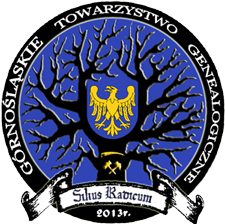





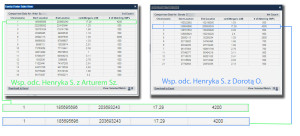

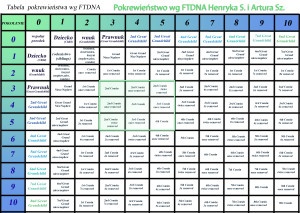


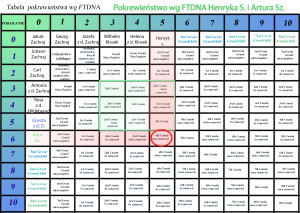
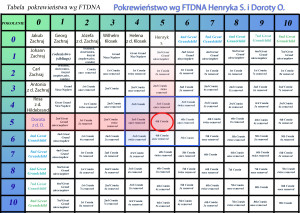
2 Comments on “Research autosomal and seeking common ancestors”
Joanna Skowron-Szalich
Thank you Damian for describing the results of research of my family members. In this case, the genetic test was a confirmation of the accuracy of the results tradyjnych genealogical. I would like to draw attention, in the case of Dorothy and Arttura (mother and son) is the same stretch of DNA. Rekombinacja, or mixing chormosomów in hand before cell division occurs in a random manner. son receives 50% Mother genetic material, but that does not mean, that half of the segment of DNA. In this case, the son was the ancestor of the DNA fragment from his mother.
As a supplement will add, the daughter of Henry described above, He has not received from the father of a DNA fragment belonging to an ancestor Jacob Zachraj.
Through the randomness of recombination in later generations increasingly difficult to determine the degree of relatedness.
Alain Temu
I find it fascinating, how autosomal DNA research can contribute to this, to trace common ancestors and uncover connections between people in the database. The article clarifies, how complex and at the same time exciting this search can be.
LG, A. Ago